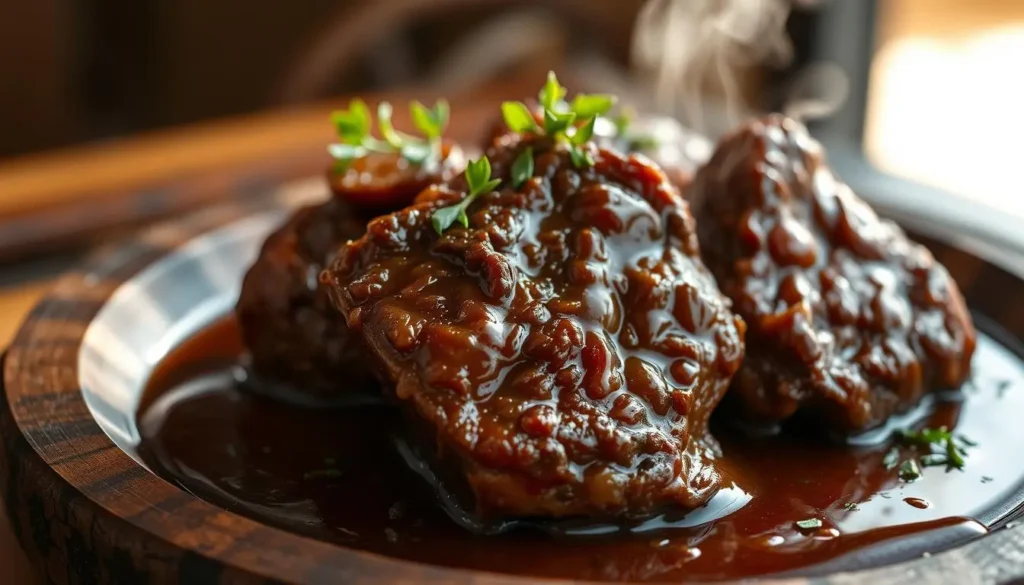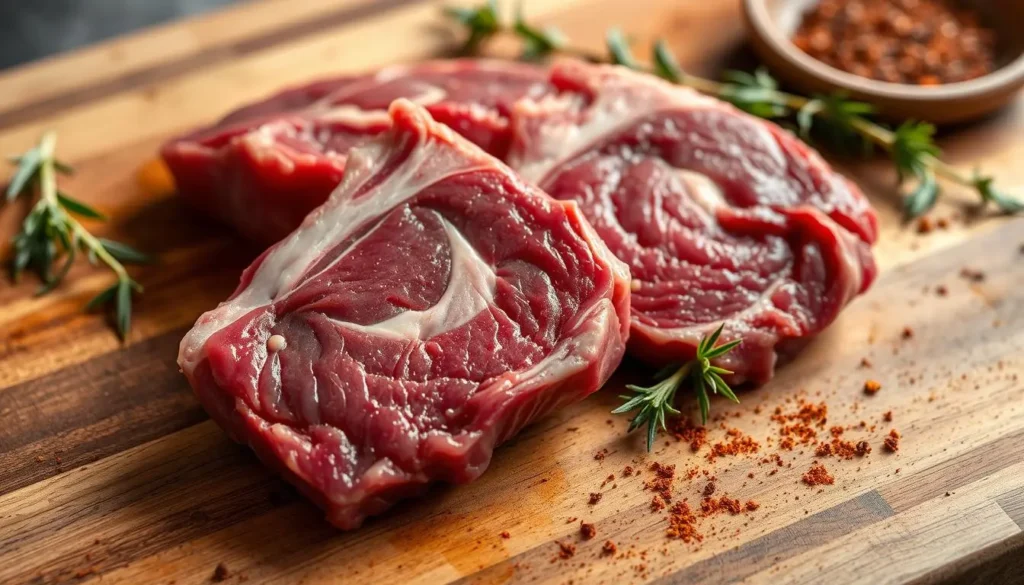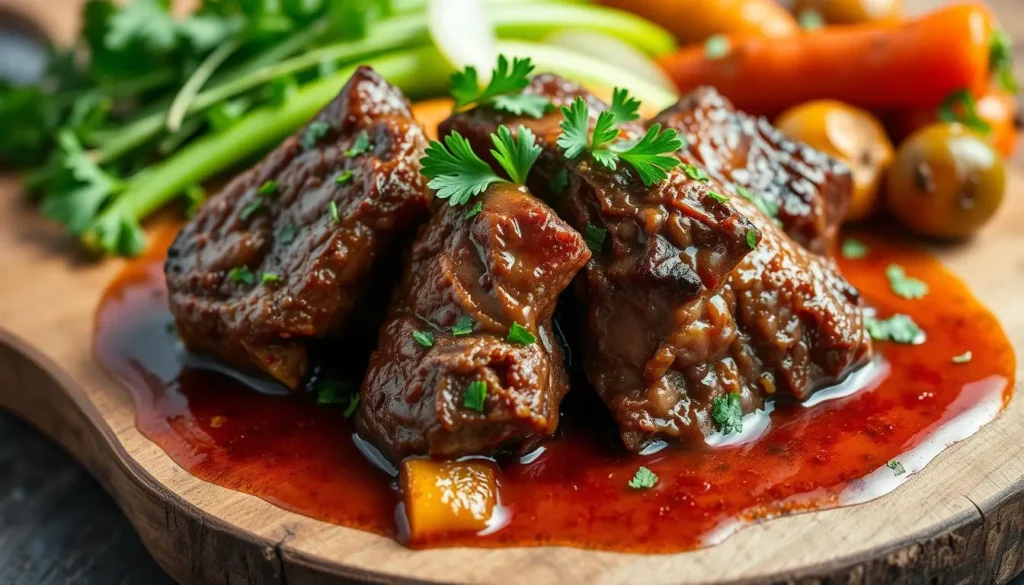Are beef cheeks good meat? Many wonder about this. Beef cheeks are gaining popularity in the U.S. They offer a unique taste and texture that sets them apart from other meats.
Beef cheeks have a distinct flavor and texture. They are becoming a favorite in kitchens across the country. This makes them a staple for many cooks.
Key Takeaways
- You’ll learn about the unique characteristics of beef cheeks and what makes them a popular choice.
- Discover the different ways to prepare and cook beef cheeks for optimal flavor and texture.
- Understand the nutritional benefits of beef cheeks and how they compare to other cuts of meat.
- Find out where to buy quality beef cheeks and how to store them for later use.
- Explore the various culinary applications of beef cheeks and how to incorporate them into your cooking repertoire.
- Learn about the cultural significance of beef cheeks in different cuisines and how they’re used in traditional dishes.

What Are Beef Cheeks and Where Do They Come From?
Beef cheeks might not be the first thing you think of when you think of beef. But, they are a delicacy in many places, known for their unique taste and texture. In the USA, they are called beef cheek meat or cheek cuts.
In Europe, they are known as cheek steaks or jaw steaks. The name changes, but their rich flavor and tender texture stay the same. You can find them in specialty butcher shops or fancy restaurants, where they are a special dish.
Anatomical Location of Beef Cheeks
Beef cheeks come from the cow’s face, specifically the masseter muscle. This muscle helps the cow move its jaw, making the meat tender and flavorful. The unique location of the beef cheeks gives them their distinct taste and texture.
Different Names Across Regions
Here are some examples of different names for beef cheeks across regions:
- USA: beef cheek meat or cheek cuts
- Europe: cheek steaks or jaw steaks
- Latin America: carne de mejilla
Cultural Significance in Various Cuisines
Beef cheeks have a big cultural impact in many cuisines. In Latin America, they are slow-cooked in tomato sauce. In Europe, they are braised in red wine. Their cultural importance shows their versatility and unique flavor.
| Region | Name | Preparation Method |
|---|---|---|
| USA | Beef cheek meat | Braised or slow-cooked |
| Europe | Cheek steaks | Grilled or pan-seared |
| Latin America | Carne de mejilla | Slow-cooked in tomato sauce |
The Unique Characteristics of Beef Cheeks
Beef cheeks have a dense muscle structure. This makes them special when cooked right. They have a lot of connective tissue, perfect for slow cooking. This method makes them tender and full of flavor.
Raw beef cheeks look tough. But, with the right cooking, they become tender and delicious. Rich flavors and a tender texture make them stand out. Cooking them low and slow is key to getting the best texture.
Some of the key characteristics of beef cheeks include:
- High connective tissue content
- Dense muscle structure
- Unique texture when cooked properly
- Rich, intense flavor profile
Understanding beef cheeks’ unique traits lets you make amazing dishes. They’re great for both experienced chefs and beginners. So, don’t hesitate to try them in your kitchen.
Are Beef Cheeks Good Meat? A Detailed Analysis
Beef cheeks are special because of their deep, beefy taste. This taste is intense and savory. It comes from the meat’s connective tissue, which softens when cooked, making it tender and juicy.
The texture of cooked beef cheeks is incredibly tender. This is because the connective tissue in the meat dissolves during cooking. This leaves it soft and velvety. To get this texture, it’s important to cook the beef cheeks slowly, letting the connective tissue break down and the meat become tender.
Flavor Profile and Intensity
The flavor of beef cheeks is a big reason why they’re considered good meat. Their rich, beefy taste gets even deeper during cooking. This is thanks to the Maillard reaction, a chemical process that happens when amino acids and sugars meet heat, creating new flavors.
Texture When Properly Cooked
As mentioned before, cooked beef cheeks are tender and juicy. This texture comes from cooking them slowly, which breaks down the connective tissue and makes the meat tender. The result is a texture that’s often called “melt-in-your-mouth” tender, making beef cheeks a favorite in many dishes.
Nutritional Benefits
Beef cheeks also have nutritional perks. They’re packed with protein, containing all the amino acids our bodies need. They’re also a good source of iron, zinc, and other important minerals, making them a healthy choice for a balanced diet.
In summary, beef cheeks are a great meat choice because of their rich flavor, tender texture, and nutritional value. Whether you’re looking to spice up your diet or just want to try something new, beef cheeks are definitely worth a try.
Understanding Beef Cheek Pricing and Value
When you think about buying beef cheeks, you might ask why is beef cheek so expensive? In some places, the demand for this meat is high, making it pricier. But in other areas, are beef cheeks a cheap cut? might be more fitting, as they could be cheaper due to local availability.
Beef cheeks are known for their rich flavor and tender texture. They require slow cooking to become tender. This effort makes them a favorite among chefs and home cooks, despite their price.
Here are some key points to consider when evaluating the pricing and value of beef cheeks:
- Quality and source of the meat
- Local market conditions and competition
- Cooking time and effort required
- Yield and serving size after cooking
- Flavor and texture profile
By looking at these factors, you can decide if beef cheeks are a good choice for your cooking and budget. Even though they might cost more than other meats, their unique taste and texture make them worth it for special meals or everyday dishes.
| Factor | Description |
|---|---|
| Quality and source | Affects the tenderness and flavor of the meat |
| Local market conditions | Influences the price and availability of beef cheeks |
| Cooking time and effort | Impacts the convenience and ease of preparation |
Preparing Beef Cheeks for Cooking
To get the most out of your beef cheeks, proper preparation is key. Start by cleaning and trimming the beef cheeks. Remove any silverskin or excess fat.
This helps the beef cheeks cook evenly and prevents a tough texture.
After cleaning and trimming, it’s time for marinating. Marinating adds flavor and tenderness. You can use olive oil, garlic, and herbs, or a store-bought marinade.
Cleaning and Trimming
- Remove any silverskin or excess fat from the beef cheeks
- Trim any excess meat or connective tissue
- Rinse the beef cheeks under cold water to remove any impurities
Marinating Techniques
- Use a mixture of olive oil, garlic, and herbs for a classic marinade
- Try a store-bought marinade for a quick and easy option
- Experiment with different flavor combinations, such as Asian-inspired or Mexican-style

Preparing delicious beef cheeks is easy with these steps. Whether you’re a pro or a beginner, getting it right is key. It brings out the meat’s full flavor and tenderness.
| Preparation Step | Importance |
|---|---|
| Cleaning and Trimming | High |
| Marinating | Medium |
| Cooking | High |
Best Cooking Methods for Beef Cheeks
When cooking beef cheeks, you want to break down the connective tissues. This makes the meat tender and full of flavor. Braising is a popular method, where you cook the cheeks in liquid over low heat for a long time. It’s perfect for braised beef cheeks because it lets the meat soak up all the flavors.
Other methods like slow cooking, pressure cooking, or sous vide also work well. Slow cooking tenderizes the meat, while pressure cooking cuts down cooking time. Sous vide offers precise temperature control.
Here are some key considerations for each cooking method:
- Braising: low heat, long cooking time, rich flavors
- Slow cooking: tenderizing, easy to prepare, flexible cooking time
- Pressure cooking: fast cooking time, tender meat, potential for overcooking
- Sous vide: precise temperature control, even cooking, potential for underseasoning
It’s crucial to cook the beef cheeks to at least 160°F (71°C) for food safety. Use a meat thermometer to check the temperature and adjust cooking time if needed.
By following these guidelines and choosing the right cooking method, you can make delicious and tender braised beef cheeks. They’re sure to impress your family and friends.
Common Mistakes to Avoid When Cooking Beef Cheeks
Cooking beef cheeks can be tricky. It’s easy to make mistakes that ruin the dish. To get tender and tasty beef cheeks, know the common mistakes and how to avoid them. You want to bring out the meat’s natural flavors without overdoing it.
Watch out for temperature control issues. Cooking too hot can make the meat tough and dry. Timing mistakes are also key. Beef cheeks need slow cooking to become tender. And, don’t let seasoning errors mask the meat’s natural taste. Finding the right balance is crucial.
Temperature Control Issues
To avoid temperature problems, cook beef cheeks at a low, steady heat. Use a slow cooker or Dutch oven for this. Low heat keeps the meat tender and juicy.
Timing Mistakes
Timing is everything with beef cheeks. They need long cooking to become tender. Cook them for 2-3 hours, or until they’re soft and easy to shred.
Seasoning Errors
Seasoning is key when cooking beef cheeks. Use a light touch to avoid overpowering the meat. A simple mix of salt, pepper, and herbs can enhance the flavors without overwhelming them.
Knowing these common mistakes helps you cook tender and flavorful beef cheeks. Whether you’re experienced or new to cooking, beef cheeks can be a rewarding dish to make.
| Mistake | Solution |
|---|---|
| Temperature control issues | Cook at a low and consistent heat |
| Timing mistakes | Cook for an extended period (at least 2-3 hours) |
| Seasoning errors | Use a light hand when seasoning (salt, pepper, and herbs) |
Buying Guide: Where to Find Quality Beef Cheeks
Looking for beef cheeks? You can find them at butcher shops or supermarkets. Butcher shops often have better quality, with more marbling and a softer texture. However, they might be pricier and harder to find.
Supermarkets, on the other hand, offer a wider selection at lower prices. But, the quality can vary. It’s important to check the products closely to find the best deal. Look for the beef’s origin, marbling, and freshness to make a good choice.
Butcher Shops vs. Supermarkets
Butcher shops offer a personal touch, letting you ask questions and get tips from experts. They can help pick the right beef cheeks for your dish and guide you on how to cook them. Supermarkets, however, have more options, including organic and grass-fed beef cheeks.
What to Look For When Purchasing
When buying beef cheeks, look for a few important things. First, check the color; it should be deep red, showing it’s fresh and good quality. Next, check the marbling; a mix of fat and lean meat makes the dish tender and tasty. Also, look for the origin and certification, like USDA Prime or Angus, to ensure quality.
By following these tips and thinking about your options, you can find the best beef cheeks for your next meal. Whether you go to a butcher or a supermarket, always choose quality and freshness for the best results.

Storage and Preservation Tips
Storing beef cheeks right is key to keeping them fresh and safe. Raw beef cheeks can stay in the fridge for 3 days. Make sure they’re in airtight containers or zip-top bags.
Freezing is great for longer storage. Wrap the beef cheeks in plastic or foil, then in a freezer-safe bag. They can last up to 8 months in the freezer. To thaw, leave them in the fridge overnight or thaw quickly in cold water.
Before cooking, always check for spoilage. Look for an off smell or slimy texture. Here are some tips for keeping beef cheeks fresh:
- Keep raw beef cheeks in the fridge at 40°F (4°C) or below.
- Freeze them at 0°F (-18°C) or below to stop bacteria growth.
- Use labels and dates on containers or bags to track storage time.
By following these tips, you can enjoy tender and delicious beef cheeks anytime. They’ll stay fresh and safe to eat.
| Storage Method | Storage Time | Temperature |
|---|---|---|
| Refrigeration | Up to 3 days | 40°F (4°C) or below |
| Freezing | Up to 8 months | 0°F (-18°C) or below |
Conclusion: Making the Most of This Unique Cut
Beef cheeks are a remarkable cut of meat. They have a rich, intense flavor and a tender, succulent texture. This makes them perfect for many dishes, like hearty braises and flavorful tacos.
By following the expert tips and techniques in this article, you can make the most of beef cheeks. You’ll get mouthwatering results in your kitchen. Whether you slow-cook them or try unique methods, you’ll enjoy an unforgettable dining experience.
So, to answer the question – yes, beef cheeks are indeed a great meat. They offer a depth of flavor and texture that’s unique. Explore this culinary gem and let your creativity shine in your dishes.
FAQ
What are beef cheeks and where do they come from?
Beef cheeks come from the cow’s cheek muscles. They are found near the jawbone on the lower head part. This unique spot makes them dense, giving them a special texture and taste.
What are beef cheeks called in the USA?
In the USA, beef cheeks are called “cheek meat” or “beef cheeks”. Some places also refer to them as “beef chuck cheeks” or “facial meat”.
Why is beef cheek so expensive?
Beef cheeks are pricey for a few reasons. They are a limited cut, with only two cheeks per cow. This limits their supply. Also, cooking them takes a lot of time, making them more expensive.
Are beef cheeks a cheap cut?
Beef cheeks can be pricey in some places but cheap in others. In Hispanic and Latin American cuisines, they are often used in dishes like barbacoa and birria. So, their cost varies by region and culture.
What is the flavor profile and texture of beef cheeks?
Beef cheeks have a rich, beefy taste that gets even better with cooking. They are very tender when cooked slowly, thanks to their high collagen content. This makes them melt in your mouth.
Are beef cheeks good meat?
Yes, beef cheeks are excellent meat. They offer a rich flavor and are packed with protein. When cooked right, they are incredibly tender and satisfying.
What are the best cooking methods for beef cheeks?
Braising is the top choice for cooking beef cheeks. It makes them tender and flavorful. Slow cooking, pressure cooking, and sous vide also work well, making them tender and delicious.
What are common mistakes to avoid when cooking beef cheeks?
Avoid cooking them too hot or for the wrong time. Also, don’t over- or under-season them. Knowing these mistakes helps ensure your beef cheeks are always tender and tasty.

